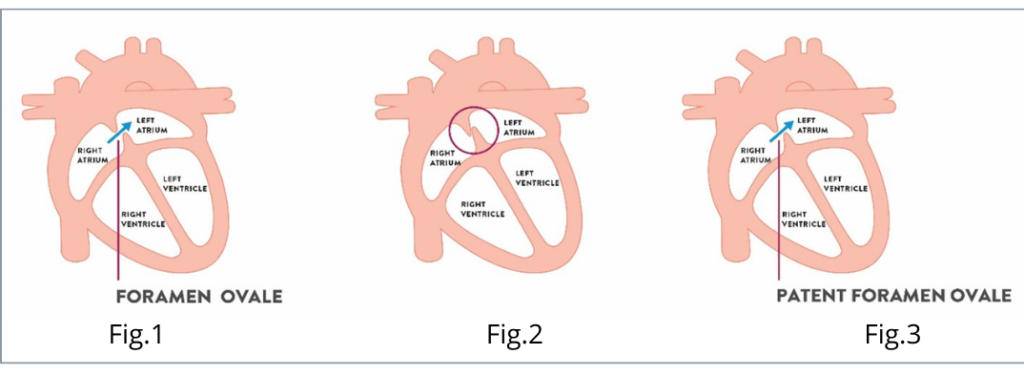Your heart and the foramen ovale
Your heart is a muscular organ in your chest that is about the size of your fist. The heart’s main function is to pump blood and supply oxygen to your entire body. Understand your heart, click here.
Before birth, there is an opening in the form of a tissue flap in the wall between the left and right upper chambers of the baby’s heart (the left atrium and right atrium). This opening (“Foramen ovale”) allows blood containing oxygen from the mother to bypass the baby’s lungs, which do not function until the baby is born. When the baby is born, the flap opening generally closes, and within a few months is it sealed completely.
What is a patent foramen ovale (PFO)
In about 25% to 33% of people (that is, one in three to four individuals), the foramen ovale tissue flap does not close completely. When the foramen ovale remains open, it is called a “patent foramen ovale” or PFO. A PFO can allow a small amount of blood to pass from the right side of the heart to the left side of the heart; this is called a “shunt”. In the vast majority of individuals, a PFO causes no medical problems whatsoever and, if found incidentally (typically in a sonogram of your heart called an echocardiogram, requires no treatment or follow up.
The open foramen ovale before birth, a closed foramen ovale after birth and a patent foramen ovale after birth are shown in the diagram below.

What is a stroke
Strokes are caused by a sudden interruption in blood flow to a part of the brain or by bleeding within the brain tissue. When this happens, brain cells are deprived of oxygen and begin to die (Brain damage). When brain cells die during a stroke, the function controlled by that part of the brain such as speech and movement may be impaired or lost completely.
What are the 2 main types of strokes?
There are 2 major types of strokes: hemorrhagic stroke and ischemic stroke.
A hemorrhagic stroke occurs when injured blood vessels in the brain allow bleeding into the brain tissue, resulting in swelling and pressure that damages the brain. Hemorrhagic strokes occur most often in patient with poorly controlled high blood pressure.
An ischemic stroke occurs when a blockage develops in a blood vessel carrying blood to the brain. The most common causes of ischemic stroke are:
- Atherosclerosis (hardening of the arteries)
That narrows the vessel opening and reduces blood flow to the brain
- A blood clot that blocks a brain artery
Most cases of blood clots are associated with a common heart condition called atrial fibrillation, which causes an irregular heartbeat. Less common causes of ischemic stroke include inflammation or tears within brain blood vessels, spasm of brain blood vessels, blood clotting disorders and blood clots associated with artificial heart valves.
What is a cryptogenic stroke, and how is the diagnosis of cryptogenic stroke made?
A cryptogenic stroke is a type of ischemic stroke in which a specific cause (such as atherosclerosis or atrial fibrillation) is not found.
Before concluding that you have has a cryptogenic stroke, your medical team consisting of a neurologist and a cardiologist will perform several important tests to look for the common and uncommon causes of ischemic stroke to guide your treatment. These tests typically include imaging studies of your brain and brain blood vessels (ultra, CT and/or MRI scans), extended monitoring of your heart rhythm, blood tests and an echocardiogram.
Understanding your treatment options
If you have been diagnosed with a PFO and cryptogenic stroke, treatment options are as follows:
- Blood-thinning medication
- Open heart surgery to close the PFO
- Device closure of the PFO
Watch the video to learn more:

